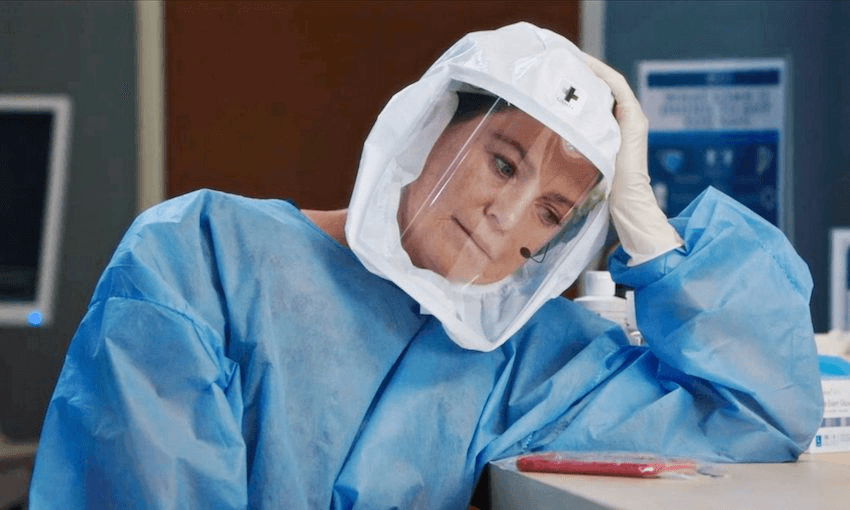It was inevitable that TV would have to deal with Covid-19 in some way. Grey’s Anatomy isn’t the first, but it’s the most significant. So how has the long-running medical drama done it?
Grey’s Anatomy is meant to be the television equivalent of a weighted blanket. Something you pull on top of you to gently crush away the stress of the week.
As a network television show entering its 17th season, the consistent delivery of 22 weekly episodes of television each year, it provides a comforting contrast to the frenetic pace of the dump-binge-forget grind-cycle of the current era of television.
Grey’s is categorically a “real world” hospital drama but the complex web of world building that’s taken place over 17 years has created a universe that’s as fictional as Game of Thrones.
The intensity of the drama has never been high stakes. There’s enough to keep you engrossed, to make you sob into your cereal – but Grey’s is not at the vanguard of television that shapes us or creates defining cultural moments. Four years and four seasons have passed and Trump hasn’t been mentioned once. The show remains largely apolitical.
There are values that shine through and quiet subversions of the mainstream norm, but Shonda Rhimes and her team have delivered a lot of this as a statement of fact and not as political statement. Women and people of colour have had senior roles at Seattle Grace, now Sloan Grey Izzy Yang McSteamy McDreamy Memorial Hospital, since the get-go. There have been nods to various movements – an episode dealing with a sexual assault in Season 15 was incredibly powerful – but there is still an awful lot of sex that goes on between colleagues, more than I would’ve thought was permissible in the #MeToo era we live in.
All of this makes the new season, which started a fortnight ago, quite unusual. As a drama about a hospital in the US, it couldn’t very well ignore the pandemic, but the thud with which reality landed in the ambulance bay was loud. Grey’s is one of the first big TV shows to deal with Covid-19 and it’s the first time a real-world event has so boldly entered the Grey’s universe.
Its closest cultural artefacts are the many episodes of television that sought to recognise 9/11 in the immediate aftermath of the event. Sex and the City did a tribute to New York episode and edited out the Twin Towers from all footage shot before 9/11. The West Wing did ‘Isaac and Ishmael’, which aired on October 3, 2001. It was a strange, standalone episode that didn’t directly address the real-world event but sought to make sense of it. Ultimately, it was too soon to neatly tie a bow on a history that was still unfolding and put the show in an awkward position of straddling both political fiction and reality.
Grey’s is also straddling odd territory with these episodes and it’s perhaps one of the risks of tackling real-time events via a show that’s never really allowed the real world to intrude. In the lead-up to the new season, Ellen Pompeo (the titular Meredith Grey), said, “We’re not responsible for politicising Covid.” Executive producer Krista Vernoff backed her on this, saying, “I think it’s our job to humanise it.” She went on to say, “I feel like the politicians have politicised an illness that affects human beings regardless of political affiliation. So our job is to make it human, not political.” Thus far, as with all previous seasons, the show remains apolitical. The enormous and sprawling world of Grey’s keeps its view narrow and internal, and it makes the episodes feel small.
Though Grey’s is addressing the pandemic head-on, the Covid-related plot points have no real sting in their tail. Even as we fleetingly hear about nurses who don’t have enough masks, there is no further development of why this is the case. One of the most powerful scenes, which could be read as a treading of the political boards, is one in which Tom Koracick breaks down after opening a shipment of PPE only to find it contains nothing but booties. There are none of the desperately needed masks.
Somehow this plot-line ends up resolving itself as a tale of personal culpability and comeuppance for Koracick. This might be superficially satisfying for fans given his involvement in a long-running love triangle, but turns away from the main reason frontline healthcare workers don’t have what they need to safely do their jobs. The lack of federal coordination on the purchasing and distribution of PPE in the US has been well documented. Would it have been such a stretch to land responsibility there rather than conveniently dumping it at the feet of one of the show’s antagonists?
As well as covering off PPE shortages, the first three episodes tackle the toll of being on the frontline and the way Black Americans are disproportionately affected by the virus. One in 1,000 Black Americans has died from Covid-19. For white Americans, it’s more like 1 in 2,100.
I don’t disagree with the sentiment about humanising Covid. Maggie Pierce (Kelly McCreary), who along with Catherine Fox (Debbie Allen), acknowledges the disparities in the way Black Americans are being impacted, and delivers a great line in episode three when one of her patients dies: “She deserved to not be a statistic.” But even in this, in the fact that it’s two Black characters who are the only ones addressing this, there is a negation of what Pompeo and Vernoff have said.
Humanising is what Grey’s has always done best, but it’s very difficult to argue that the US experience of the pandemic, and the people whose lives have been affected by it, isn’t political. That it hasn’t been shaped by the divisive politics and total ineptitude of the Trump administration. That PPE shortages are the result of personal failings by healthcare workers, instead of a lack of leadership and will, and that the death of so many people couldn’t have been avoided if ego had been set aside and the right calls had been made at the right time.
As one of the first cabs off the ranks in building the cultural canon of the pandemic, Grey’s won’t be the last show to struggle with how to treat close history, or in this instance, real-time events. We are not looking at this through a rear-view mirror yet. Filming started for this new season on September 8 this year, a day when 28,941 cases of Covid-19 were recorded in the US. On November 25, 180,830 were recorded. The treatment of the pandemic in film and television is a long way off being historical.
Covid-19 has been carried into Grey’s, but the show has kept a safe social distance from any meaningful challenge to the US government. It might be a comfortable blanket for someone like me, living in New Zealand where political power has helped keep us relatively safe, but the Grey’s neutrality code offers little escapism or justice to viewers elsewhere who will continue to live, and die, affected by the inaction of those in the theatres of power.
You can watch Grey’s Anatomy on TVNZ2 on Friday nights at 9pm.



